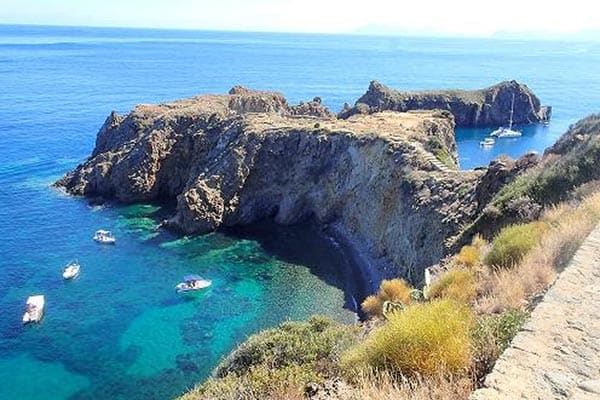
Syracuse
By Susan McKee
Syracuse — or, as the Sicilians prefer to spell it, Siracusa, is a great place to start an exploration of the island off the toe of the “boot” of Italy.
It’s where the written history of Sicily begins — in 734 BCE — when Greek colonists from Corinth landed on the small island of Ortygia — and stayed.
Although the growing settlement quickly spread to the mainland, Ortygia’s atmospheric tangle of alleyways connecting palace-lined piazzas make for great wandering (and, yes, there are lots of shops and cafés along the way).
The layers of history are obvious even to the casual observer. For example, the duomo — Roman Catholic cathedral — is built on the skeleton of the ancient Greek temple to Athena, and the Doric columns from the original are clearly visible both inside and out. A statue of the Virgin Mary stands atop the roof in the same spot once occupied by a golden image of Athena.

Papyrus once grew in profusion in the rivers around Siracusa — imported from Egypt by the Greeks around the third century BCE. The Fontana Aretusa on Ortygia includes a small spring-fed pond with fish, fowl, and lush stands of papyrus. You can learn more about this once essential writing material at the Papyrus Museum.
Leonardo’s Museum
A more animated place to visit is the Museum of Leonardo da Vinci and Archimedes. The latter — a Greek mathematician, physicist, engineer, inventor, and astronomer (active in the third century BCE) — was a native of Siracusa. Among his inventions on display are the screw pump (used to transfer water to irrigation ditches), and various pulleys and levers.
Da Vinci (who was, of course, NOT from Siracusa but Tuscany) is represented by scale models of many of his inventions, considered to be sparked by Archimedes’ work. The fun part? Almost all of the machines “work”. If there’s a teen or tween in your traveling party, this is a must-stop.
Palermo
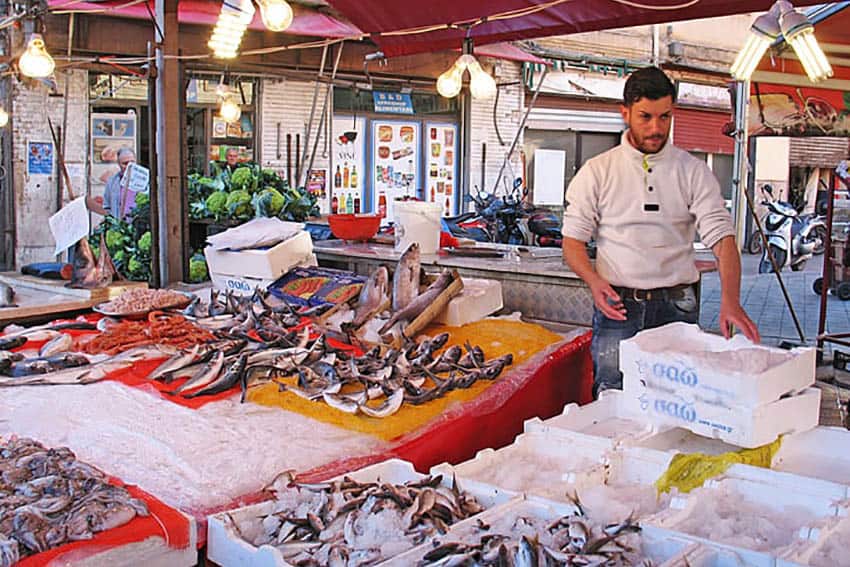
Palermo, on the northwest coast, is Sicily’s largest city and its administrative capital. More than 3000 years old, it was established by the Phoenicians, and then taken over by waves of successor regimes (Romans and Arabs among them).
It’s perhaps best known as the capital of Norman Sicily. It was here that the first Norman king established his rule in 1072. Yes: that’s right. Just six years after his compatriot, William the Conqueror, killed the last Saxon ruler of Britain, Roger I set up Norman rule in the “kingdom of the sun”.
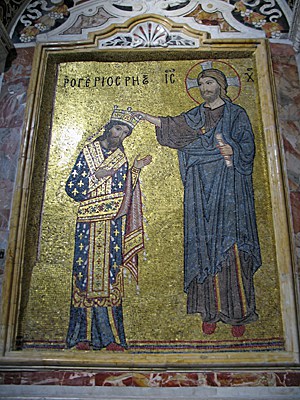
Many remnants of Norman Sicily remain: for example, the mosaic of Christ crowning Roger II in Chiesa di Santa Maria dell’Ammiraglio (better known as La Martorana — at right) and Palazzo dei Normanni, occupied these days by the Sicilian Parliament.
Museum of the Inquisition
More recent Sicilian history can be seen at the Museum of the Inquisition (Sicily was subject to the inquisition when it was under Spanish rule) and the grand neoclassical opera house, Teatro Massimo.
Just outside town is the Cathedral of Monreale, considered one of the greatest examples of Norman architecture still existing. It was begun in 1174 by the last Norman king, William II of Sicily. Since 2015 it is part of the Arab-Norman Palermo and the Cathedral Churches of Cefalù and Monreale UNESCO Heritage site.
Cefalù

On the north coast of Sicily is a town known for its great beaches along the Tyrrhenian Sea. However, clustered in the old city center are magnificent remnants of the Norman period that are included in the UNESCO World Heritage Site.
The Cathedral of Cefalù is a Roman Catholic basilica erected in 1131 with a singular reason to visit: a Byzantine-style mosaic on the semi-dome of the apse portraying Christ Pantokrator (“Christ Almighty”). Norman rulers looked to Constantinople for artistic and religious inspiration, and this enormous mosaic is one result. It’s decades older than those at Monreale.

Noto
About 24 miles southwest of Siracusa is the hill town of Noto, originally settled by the Sicels, an Italic tribe who inhabited eastern Sicily during the Iron Age. (“Sicily” is derived from Sicel.)
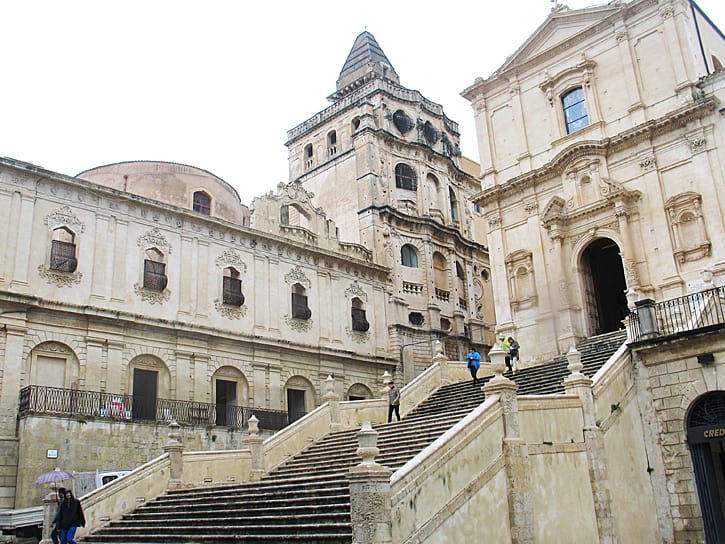
Although the ancient settlement was obliterated by an earthquake in 1693, Noto was completely (and elegantly) rebuilt in the early 18th Century. Due to its location in the foothills of the Hyblaean Mountains, steep inclines and long stairways are everywhere.
Noto and its cathedral (finished in 1776) were named a UNESCO World Heritage Site in 2002.
Erice
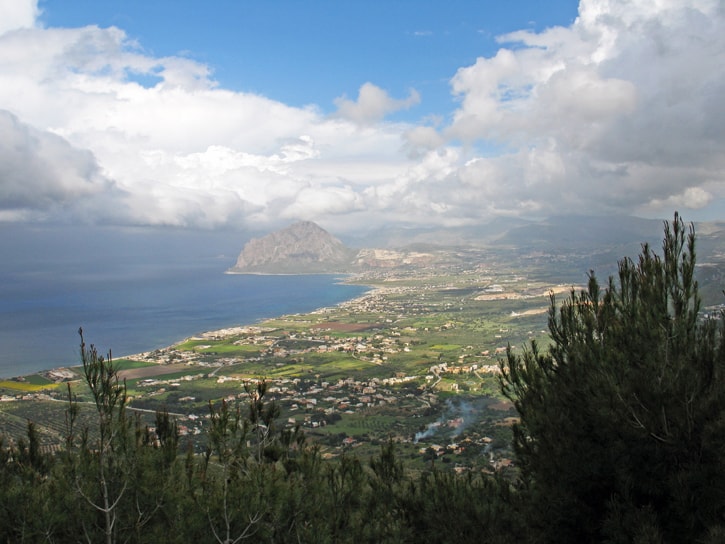
Considered Western Sicily’s most picturesque hilltop village, Erice is perched on Eryx Mountain almost half a mile above the port town of Trapani.
It retains much of its medieval wall and architecture — buildings were constructed of locally quarried white stone — although its main claim to fame comes from its earlier history as a center for the cult of Venus (when the Romans were there) and, before that, the cult of Aphrodite (for the Greeks) and before that, the cult of Astarte (for the Phoenicians). The Normans used stones from the temple dedicated to Venus to build the Castello de Venere, impressively sited on a sheer cliff face. The castle, and the earlier temple, were so enormous as to serve as a navigation marker for sailors.
And, Finally
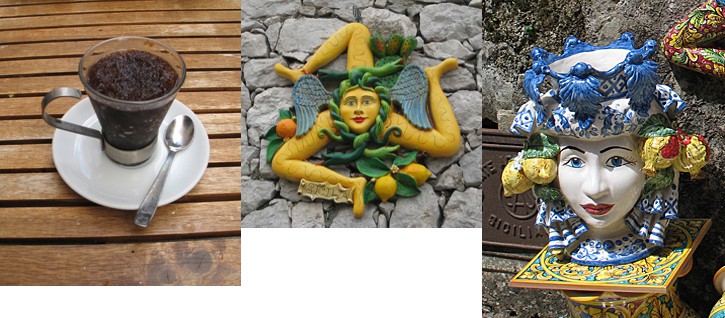 No matter where you go on Sicily you’ll find cafés serving espresso (of course) but also granita (above, left). On a hot afternoon, it’s more refreshing to spoon your coffee in icy, granulated frozen form. You’ll see the trinicria (above, center) reproduced in many variations on flags, mugs, pins, and wall plaques in Sicily. It represents the three capes of the triangular island. One of the ubiquitous sights everywhere on Sicily is the head-shaped planter — mostly depicting men, but sometimes women (above, right). The back story dates to the time of Muslim rule in the ninth and 10th centuries. A local woman became enraged when she discovered that her lover had a wife and children back home in North Africa. She cut off his head and planted it with basil.
No matter where you go on Sicily you’ll find cafés serving espresso (of course) but also granita (above, left). On a hot afternoon, it’s more refreshing to spoon your coffee in icy, granulated frozen form. You’ll see the trinicria (above, center) reproduced in many variations on flags, mugs, pins, and wall plaques in Sicily. It represents the three capes of the triangular island. One of the ubiquitous sights everywhere on Sicily is the head-shaped planter — mostly depicting men, but sometimes women (above, right). The back story dates to the time of Muslim rule in the ninth and 10th centuries. A local woman became enraged when she discovered that her lover had a wife and children back home in North Africa. She cut off his head and planted it with basil.
- Sicily’s Special Places: Here are Five Favorites - March 12, 2020
- A Summer Cruise in the High Arctic - September 26, 2019
- The Tangled Cultures of Goa, India - March 8, 2019





